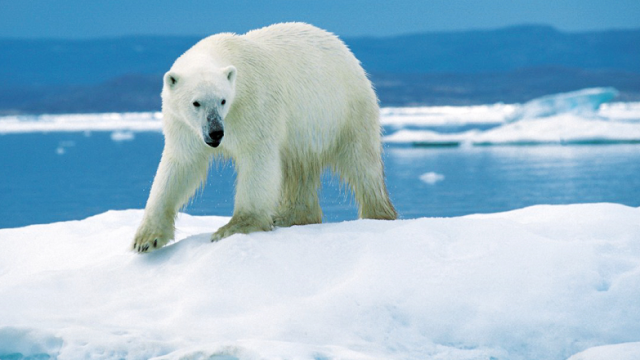Polar bears are the furry poster children for the impact of warming Arctic seas, but new research says they may be able adapt and survive the loss of Arctic sea ice by foraging on land.
Typically, the polar bears of western Hudson Bay take to the sea ice to hunt ringed seal pups in the spring. Baby seals are a high-calorie meal, and during the spring hunt, polar bears build up the stores of fat that they will live on during the summer months, when the sea ice recedes and they’re stuck on land.
The problem for polar bears is that, as Artic waters heat up, the sea ice is melting earlier every year, and it’s receding farther. That means polar bears have to swim farther to reach their sea ice hunting grounds, and it means they have a shorter hunting season every year.
http://sploid.gizmodo.com/watching-despe…
By 2068, polar bears are likely to be stuck ashore, cut off from their main food source, for about half the year. As a result some ecological models predict that between 28 per cent and 48 per cent of adult male polar bears will starve to death during the 180 days without access to their sea ice hunting grounds.
According to ecologists Linda Gormezano and Robert Rockwell, those models leave out something important: the land around Hudson Bay is full of food for polar bears in the summer months, and it looks like the bears will adapt by replacing seals with caribou, snow geese, and berries.
In a study published in the journal PLOS ONE, the researchers calculated the amount of energy that western Hudson Bay’s polar bears would need to get from food on land in order to offset the loss of calories from seal hunting during the ice-free period. Then they calculated the number of calories available from snow geese, eggs, and caribou on the shores of western Hudson Bay. Of course, it takes energy to obtain food, especially to hunt and kill big prey like a caribou, but even when the researchers subtracted the energy cost of obtaining food, they found that the shores of Hudson Bay offered plenty of calories to get polar bears through the ice-free summer months.
Good News for Polar Bears
The food is there, but will they make the switch? According to Gormezano and Rockwell, the answer is probably yes.
Polar bears, especially young bears and family groups, have always done some foraging on shore, such as browsing for berries or hunting snow geese and stealing their eggs. At least some adult male polar bears probably also supplement their diets with terrestrial food, according to the researchers’ observations. “Polar bears are opportunities, and have been documented consuming various types and combinations of land-based food since the earliest natural history records,” they wrote.
Polar bears in Manitoba have even been seen ambushing caribou with the same tactics they use for seals. In fact, Gormezano and Rockwell say that caribou are comparable to seals in size and calorie content, and the average polar bear would need to bring down a caribou only about every 27 days to stave off starvation for the whole 180 day ice-free period.
Since polar bears are already including some of these terrestrial foods in their diets (think of it as surf-and-turf), the researchers say it’s likely that they will forage more on land as their access to seals diminishes. And as the polar bears come ashore earlier in the spring, they will be on land for more of the caribou’s calving season and the period when snow geese lay their eggs. That gives polar bears more access to calorie-rich food sources, and researchers say that western Hudson Bay’s geese and caribou can handle the added predation without too much strain on their populations.
That could be good news for polar bears. Whether it works in the long run, however, will depend on several factors, such as how successful individual polar bears are at hunting caribou, and how well the geese and caribou themselves adapt to changes in the Arctic climate. Even with those caveats, however, the future looks more hopeful for polar bears than has previously seemed possible.
[PLOS ONE]
Top image: Ansgar Walk via Wikimedia Commons
